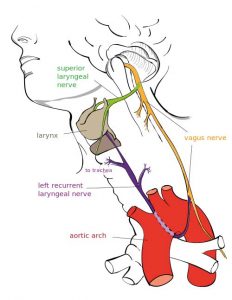The Vagus Nerve
Researchers are discovering that the vagus nerve, has a significant impact on the symptoms of a variety of disorders. Evidence shows that stimulating the vagus nerve, a process called vagus nerve stimulation (VNS) can reduce symptoms of depression and anxiety, autism, aid in stroke recovery, and even influence all of sensory systems in our bodies.
Vagus Nerve Stimulation (VNS)

Traditional VNS is a treatment that requires neurosurgery to place an implant in the patients’ brain. Although the treatment has proven beneficial, this type of VNS is risky and can result in problematic, even disabling side-effects.
However, there is also a form of non-invasive VNS, which eliminates the need for challenging surgery, called transcutaneous VNS. This method stimulates the vagus nerve via electrodes that sit in the ear like headphones. Then, there is bone conduction.
Bone Conduction
All materials conduct sound, some better than others. For example, water is a well-known conductor for whales’ voices over long distances. Your human voice is carried by both air (to the outer ear) and bone (to the inner ear) whenever you speak. Hearing the resonance of your own voice internally when you speak accounts for the difference in how your voice sounds to you when played back from a recording, when you hear only the air conducted sound.
Parasympathetic Nervous System and Calming
The vibrations are carried by bone to the area surrounding the middle and inner ear (cochlea/vestibular apparatus), which play a key role in our hearing, balance, coordination and our ability to filter out unwanted noise. It is also an area which is connected to our Parasympathetic Nervous System (PNS) through the Vagus Nerve. Parasympathetic stimulation facilitates our relaxation response (as opposed to our Sympathetic Nervous System, which gives us “fight or flight”).
Unyte and the Parasympathetic Nervous System
The iLs’ auditory program stimulates the parasympathetic system through the vagus nerve which influences our heart rate, sweating, mouth and throat muscles involved in speech, as well as our bowels and digestion. Many children and adults beginning iLs programs are in a state of hyper-arousal, not far from “fight or flight.” The gentle stimulation of the PNS brings about a balance of the ANS (autonomic nervous system controls many organs and muscles that work in an involuntary, reflexive manner) which is reflected by increased ability to express oneself calmly.


 © 2025 Unyte Health US Inc.
© 2025 Unyte Health US Inc.